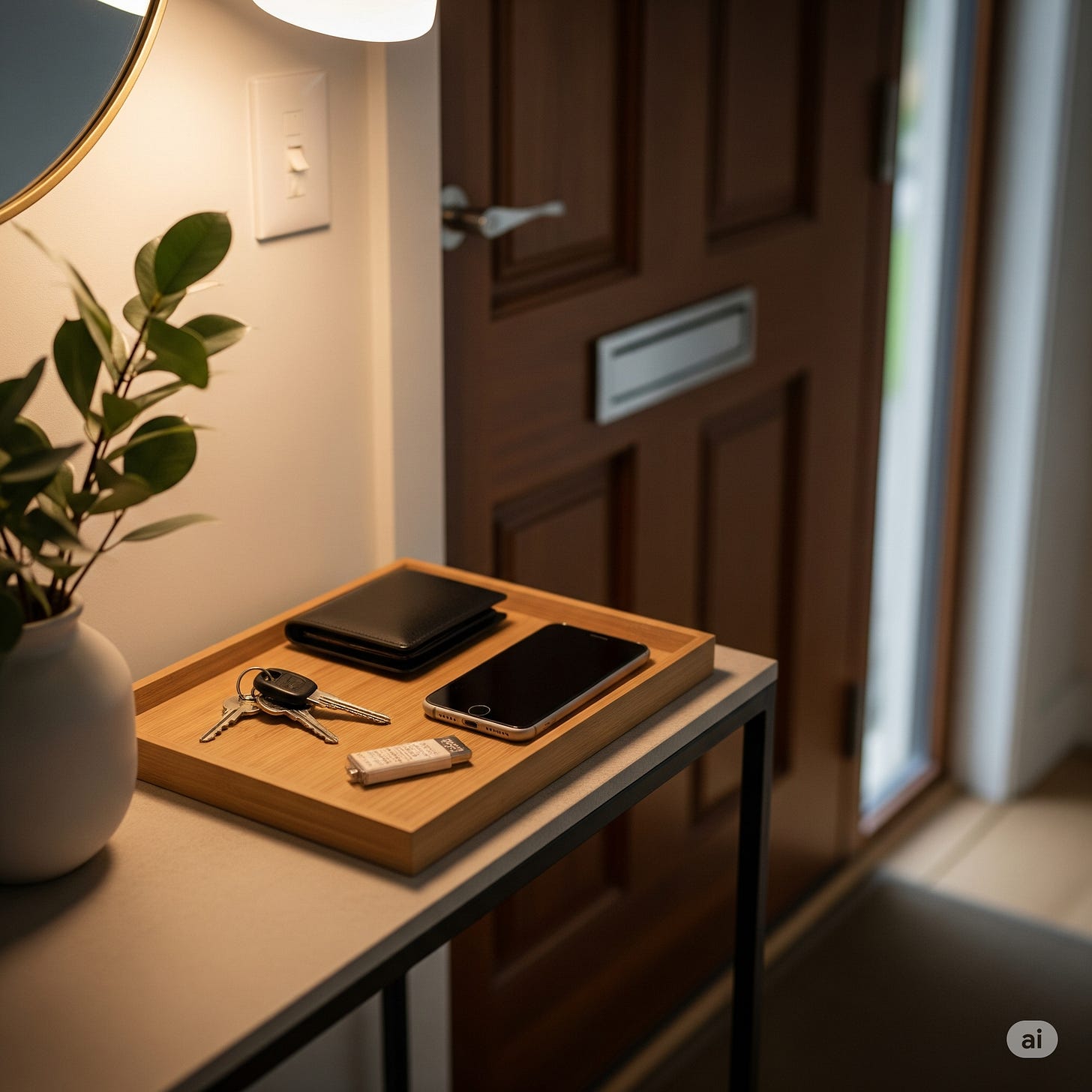The Environment as an Ally: Designing Spaces for Optimal ADHD Performance
The Silent Influence of Space
You've meticulously planned your day. You've mastered the productivity methods. You've summoned every ounce of willpower. Yet somehow, your focus still fragments. Your productivity stalls. Your disciplined intentions dissolve into chaos.
Here's the overlooked truth: The battle isn't just within you—it's in the unseen forces of your surroundings.
For ADHD minds, your environment is never neutral. It's either a silent saboteur undermining every effort, or a powerful ally amplifying your natural strengths. That pile of papers on your desk? It's not just clutter—it's a constant drain on your executive function. The endless notifications on your phone? They're not minor interruptions—they're systematic destroyers of deep focus.
This isn't about aesthetics or conventional "decluttering." This is about engineering your spaces to work with your unique neurology, not against it.
The heightened importance of environmental design for ADHD brains stems from fundamental neurobiological realities:
Expansive sensory processing makes you profoundly susceptible to visual, auditory, and digital noise
Inhibitory control challenges mean filtering irrelevant stimuli requires disproportionate cognitive resources
Working memory constraints necessitate clear external cues and minimal ambiguity to initiate and sustain tasks
This article introduces Performance-Aligned Environmental Design—the conscious transformation of your physical and digital spaces into intelligent extensions of your brain. By architecting these environments with strategic precision, you make optimal performance not a constant struggle, but the natural path of least resistance.
Physical Architecture: Designing Your Tangible Ally
Your physical environment exerts unceasing influence on your cognitive state. For ADHD minds, unmanaged physical chaos silently undermines even the most rigorous intentions. Conversely, a strategically designed space becomes a proactive ally, reducing friction and providing unwavering cues for sustained performance.
The "Landing Strip" Protocol: Eliminating Decision Fatigue
One of the most insidious drains on ADHD executive function is the daily "Where did I put it?" dilemma. Every search for keys, wallet, or phone burns precious cognitive resources that should fuel productive work.
Solution: Create designated "landing zones" for essential items.
Implementation: Establish a specific, highly visible location near your entry point or primary workspace. This could be a small tray, wall organizer, or dedicated drawer that becomes the non-negotiable home for:
Keys and wallet
Phone and earbuds
Daily medication
Papers requiring immediate processing
The objective: Make placing and retrieving these items a mindless, frictionless reflex. No more frantic morning searches. No more decision fatigue about where things belong.
Visual Noise Reduction: Creating Cognitive Calm
The ADHD brain processes visual stimuli with heightened intensity. Every visible item competes for attention, creating a constant background drain on focus capacity.
Strategic minimization isn't about aesthetics—it's about cognitive preservation.
Implementation strategies:
Utilize closed storage extensively: drawers, cabinets, and opaque bins to conceal items when not in active use
Create single-purpose zones: Your work desk is exclusively for work, not bills or personal items
Apply the "blank canvas" principle: Clear surfaces signal to your brain that this space is ready for focused work
Remember: "Out of sight, out of mind" becomes a tactical advantage for the sensory-sensitive ADHD brain. Each hidden distraction is one less cognitive battle to fight.
Dedicated Zones for Dedicated Focus: Environmental Cueing
Your brain is a masterful pattern recognizer. By creating distinct physical environments for specific activities, you train your mind to transition seamlessly into appropriate mental states.
Zone creation examples:
Deep work desk: Stripped of all non-essential items, triggering intense focus the moment you sit down
Relaxation corner: A comfortable chair exclusively for reading or unwinding
Standing station: Reserved for high-energy brainstorming or phone calls
Each zone becomes an environmental cue, silently communicating: "This is where we do X."
The Strategic "One In, One Out" Rule
Preventing accumulation is as critical as initial decluttering. For ADHD minds, this rule requires an additional filter.
Enhanced implementation: For every new item entering a space, ask:
Does this serve my focus and productivity?
Does it reduce friction in my daily routines?
Or does it add to cognitive burden and visual noise?
If it doesn't actively support your performance, it doesn't earn a place in your optimized environment.
Micro-Resets: The Five-Minute Sweep
Chaos accumulates exponentially when left unchecked. Short, frequent interventions prevent overwhelming buildup—crucial for ADHD brains that struggle with initiating large organizational tasks.
The power lies in consistency, not perfection.
Daily implementation: Dedicate precisely five minutes at a consistent time (end of workday, before dinner, or first thing in the morning) to:
Return cups to the kitchen
File loose papers
Clear desk surfaces
Reset tools to their designated homes
This seemingly trivial act prevents the exponential growth of disorder and maintains environmental momentum. Five minutes daily eliminates hours of overwhelming cleanup later.
Digital Architecture: Engineering Your Virtual Sanctuary
Your digital environment may be even more influential than your physical space. For ADHD minds, the chaotic digital realm—with its endless notifications, infinite feeds, and fragmented information—represents a perpetual assault on focused attention.
Just as you architect physical spaces, you must ruthlessly engineer your virtual sanctuary.
Notification Annihilation: Sterilizing Digital Intrusions
The constant stream of digital alerts creates a dopamine-driven distraction pipeline, training your brain to crave interruption over sustained focus. For ADHD individuals, this pull is particularly dangerous.
Your first mission: Conduct a notification audit and show no mercy.
Implementation protocol:
Review every notification across all devices (email, messaging apps, social media, news, system alerts)
Disable all non-essential alerts immediately
Keep only genuinely critical notifications: direct calls from close contacts, true emergencies
Relegate everything else to scheduled batch-processing times
Result: Your devices become tools for intentional use, not constant interruption.
Digital Landing Strips: Taming Information Overload
Unprocessed digital inputs function as persistent mental "open loops," silently consuming cognitive resources. Your digital spaces need the same strategic organization as physical ones.
Digital organization strategies:
Email Inbox Management:
Treat inbox as a processing funnel, not storage
Process each message immediately: delete, archive, respond, or move to "action required" folder
Aim for inbox zero daily to eliminate mental burden
Download Organization:
Create a "To Process" folder for immediate sorting
Move downloads from default folder within 24 hours
Delete or file everything—no digital dumping grounds
Cloud Storage Structure:
Mirror your physical filing system digitally
Use consistent naming conventions (YYYY-MM-DD_ProjectName_Description)
Create project-specific folders with clear hierarchies
Browser and Application Segmentation: Digital Compartmentalization
Frequent context switching devastates ADHD executive function. Your digital tools can create distinct compartments for different activities, minimizing transition costs.
Create separate digital identities for different modes of work.
Implementation examples:
Work Browser Profile: Contains only work-related tabs, extensions, and bookmarks
Personal Browser Profile: For leisure browsing, social media, personal research
Focus Mode Profile: Stripped-down environment with blocking extensions enabled
When you open a specific profile, your brain receives a clear signal: "We're in X mode now."
Strategic App Placement: Engineering Digital Flow
The layout of your devices profoundly impacts usage patterns. Make productive actions effortless and distracting ones difficult.
Phone optimization strategies:
Home screen: Only essential productivity apps (calendar, task manager, notes)
Second screen: Utilities and tools
Hidden in folders: Social media and entertainment apps
Deleted during focus periods: Most problematic apps removed entirely
Each extra tap required to access a distraction creates a micro-moment for conscious choice.
Behavioral Architecture: Engineering Automatic Success
Beyond organizing spaces, you can actively engineer environments to shape behavior—making desired actions effortless while creating deliberate friction for unwanted ones.
Cue Engineering: Making Good Choices Obvious
The ADHD brain excels at responding to immediate, salient stimuli. Transform your environment into a silent director, consistently nudging you toward high-value actions.
Physical cue examples:
Workout clothes laid on your pillow the night before
Water bottle positioned prominently on your desk
Current book placed on your nightstand or coffee table
Medications next to your toothbrush
Digital cue examples:
Desktop shortcuts to current project files only
Browser homepage set to task management app
Phone wallpaper displaying current goals
Calendar notifications that auto-open relevant documents
Each strategically placed item becomes a non-verbal command, eliminating decision friction.
Friction Engineering: Making Poor Choices Difficult
Just as you eliminate friction for desired behaviors, deliberately introduce it for unwanted ones. This proactive defense builds protective barriers against impulsive actions.
Physical friction strategies:
Store tempting snacks in hard-to-reach places
Unplug the TV after each use
Remove batteries from remote controls
Place phone charger in another room during sleep
Digital friction strategies:
Log out of social media after each session
Enable app time limits with complex override passwords
Use website blockers during work hours
Remove saved passwords for time-wasting sites
The goal: Make the path of least resistance the productive path.
Micro-Reward Zones: Immediate Gratification for Good Behavior
The ADHD brain thrives on immediate rewards. Instead of fighting this tendency, leverage it strategically.
Implementation ideas:
Physical reward station: Special tea or coffee accessible only after task completion
Digital reward bookmark: Curated playlist or video available post-focus session
Sensory rewards: Essential oil diffuser activated after finishing work blocks
Visual progress tracking: Physical tokens moved to "complete" jar after each task
Key principle: Rewards must be immediate and conditionally accessible, training your brain to associate task completion with positive outcomes.
Pre-Loading Decisions: Eliminating Daily Friction
Decision fatigue disproportionately affects ADHD executive function. Pre-make choices within your environment to liberate cognitive resources.
Physical pre-decisions:
Entire week's outfits selected on Sunday
Meal ingredients pre-portioned in containers
Work materials organized in "grab and go" bags
Morning routine items arranged in usage order
Digital pre-decisions:
Email templates for common responses
Project templates with standard structures
Recurring calendar blocks for routine tasks
Automated bill payments and subscriptions
Every pre-made decision is cognitive energy saved for what matters most.
Sustaining Your Environmental Alliance
Transforming your environment into an ally isn't a one-time event—it's an ongoing practice requiring regular attention and strategic adaptation.
Environmental Audits: Your Maintenance Protocol
Just as high-performance systems require monitoring, your optimized environment demands regular inspection and adjustment.
Audit schedule:
Weekly (15 minutes): Quick scan for emerging friction points
Monthly (30 minutes): Deeper review of what's working and what needs adjustment
Quarterly (60 minutes): Comprehensive evaluation and strategic planning
Audit questions to ask:
What environmental elements are serving their intended purpose?
Where is clutter or chaos beginning to creep back?
Have my needs or workflows changed, requiring environmental updates?
Which strategies have proven most effective and deserve expansion?
Adaptive Design: Your Living Laboratory
Your environment should evolve with your needs. Rigid adherence to initial designs can create new friction points.
Embrace experimentation:
If a system isn't working after two weeks, modify it
Test new configurations during low-stakes periods
Document what works for future reference
Share successful strategies with others facing similar challenges
Remember: The goal is function, not perfection.
Identity Reinforcement Through Environmental Mastery
The most powerful motivator for maintaining your optimized environment is connecting it to your evolving identity.
Each time you maintain your space, you're voting for the identity of someone who:
Commands their environment for peak performance
Prioritizes clarity over chaos
Takes ownership of their ADHD management
Creates conditions for success rather than hoping for it
This isn't just organizing—it's becoming the architect of your own success.
Your Environmental Transformation Starts Now
We've systematically revealed how your physical and digital environments actively shape your daily performance. From establishing landing strips to annihilating notifications, from engineering behavioral cues to instituting regular audits, you now possess the blueprint for environmental mastery.
But knowledge without action yields zero results.
Your Three-Step Implementation Protocol
Step 1: Identify Your Primary Chaos Point Scan your environment right now. What single area consistently drains your energy or disrupts your focus?
That perpetually cluttered desk corner?
The overwhelming phone notifications?
The chaotic Downloads folder?
The missing landing zone for daily essentials?
Step 2: Choose One Design Principle Select the strategy that most directly addresses your chaos point:
Landing Strip Protocol for lost items
Notification Annihilation for digital overwhelm
Visual Noise Reduction for cluttered spaces
Zone Creation for lack of focus areas
Step 3: Implement Within 60 Minutes Don't analyze. Don't perfect. Just execute. Set a timer and transform that single chaos point into an ally.
The profound liberation of an optimized environment awaits—but only if you act.
The Compound Effect of Environmental Mastery
Each small environmental optimization creates a ripple effect:
Less time searching means more time creating
Fewer distractions mean deeper focus sessions
Clearer spaces mean calmer mental states
Better systems mean sustainable success
Your environment shapes your days. Your days shape your life.
What chaos point will you conquer first? Which design principle will you implement today?
Your journey from environmental chaos to strategic advantage begins with one decisive action. Take it now.




